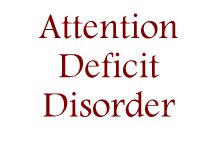
|
|
|
The top ten behaviors of Attention Deficit Disorder (ADD) are; Distractibility, Lack of impulse control, Free flight of ideas, Difficulty with organizing or sequencing tasks, Social immaturity, Forgetfulness, Difficulty with deferred gratification, Difficulty sequencing and following directions, Restlessness or Hyperactivity, Difficulty with concentration, Difficulty with dates, times or directions.
This disorder has been identified in medical literature more than 100 years ago. A popular German tale (Hoffmann's "Struwel Peter") written in rhyme for children portrays a child with ADHD. |

|
|
|

The A.D.D. Quest for Identity : Inside the Mind of Attention Deficit Disorder
|
|
Contact: Ascend |
 Beyond ADD : Hunting for Reasons in the Past & Present by Thom Hartmann. One of the pioneers of ADD research shows how individuals with ADD are not just "hyperactive" or "easily distracted," but actually possess highly adaptive, entrepreneurial skills--traits which served ancient hunters but meet with resistance in modern agrarian societies. This book shows how people with the same diagnosis can exhibit different behaviors and possible genetic origins and ADD-related traits are explored and discussed. |
